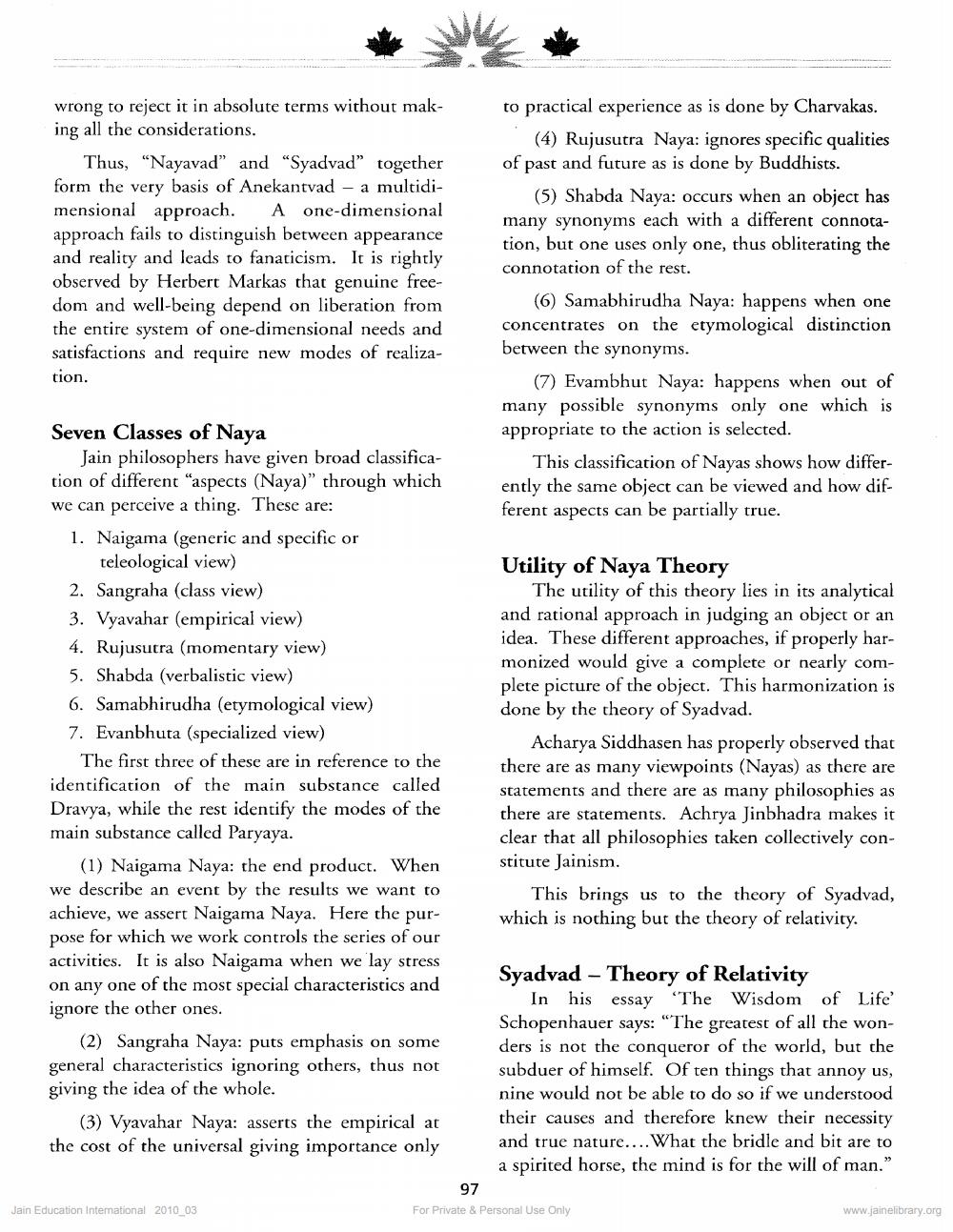________________
wrong to reject it in absolute terms without making all the considerations.
Thus, "Nayavad" and "Syadvad" together form the very basis of Anekantvad - a multidimensional approach. A one-dimensional approach fails to distinguish between appearance and reality and leads to fanaticism. It is rightly observed by Herbert Markas that genuine freedom and well-being depend on liberation from the entire system of one-dimensional needs and satisfactions and require new modes of realization.
Seven Classes of Naya
Jain philosophers have given broad classification of different "aspects (Naya)" through which we can perceive a thing. These are:
1. Naigama (generic and specific or teleological view)
2. Sangraha (class view)
3. Vyavahar (empirical view)
4. Rujusutra (momentary view)
5. Shabda (verbalistic view)
6. Samabhirudha (etymological view)
7. Evanbhuta (specialized view)
The first three of these are in reference to the identification of the main substance called Dravya, while the rest identify the modes of the main substance called Paryaya.
(1) Naigama Naya: the end product. When we describe an event by the results we want to achieve, we assert Naigama Naya. Here the purpose for which we work controls the series of our activities. It is also Naigama when we lay stress on any one of the most special characteristics and ignore the other ones.
(2) Sangraha Naya: puts emphasis on some general characteristics ignoring others, thus not giving the idea of the whole.
(3) Vyavahar Naya: asserts the empirical at the cost of the universal giving importance only
Jain Education International 2010_03
to practical experience as is done by Charvakas.
(4) Rujusutra Naya: ignores specific qualities of past and future as is done by Buddhists.
(5) Shabda Naya: occurs when an object has many synonyms each with a different connotation, but one uses only one, thus obliterating the connotation of the rest.
(6) Samabhirudha Naya: happens when one concentrates on the etymological distinction between the synonyms.
(7) Evambhut Naya: happens when out of many possible synonyms only one which ist appropriate to the action is selected.
This classification of Nayas shows how differently the same object can be viewed and how dif ferent aspects can be partially true.
Utility of Naya Theory
The utility of this theory lies in its analytical and rational approach in judging an object or an idea. These different approaches, if properly har monized would give a complete or nearly complete picture of the object. This harmonization is done by the theory of Syadvad.
Acharya Siddhasen has properly observed that there are as many viewpoints (Nayas) as there are statements and there are as many philosophies as there are statements. Achrya Jinbhadra makes it clear that all philosophies taken collectively constitute Jainism.
This brings us to the theory of Syadvad, which is nothing but the theory of relativity.
Syadvad - Theory of Relativity
In his essay 'The Wisdom of Life' Schopenhauer says: "The greatest of all the wonders is not the conqueror of the world, but the subduer of himself. Of ten things that annoy us, nine would not be able to do so if we understood their causes and therefore knew their necessity and true nature....What the bridle and bit are to a spirited horse, the mind is for the will of man."
97
For Private & Personal Use Only
www.jainelibrary.org




